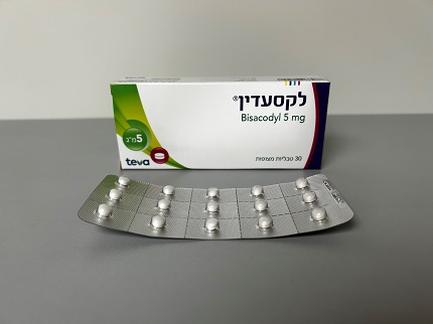Quest for the right Drug

לקסעדין LAXADIN (BISACODYL)
תרופה במרשם
תרופה בסל
נרקוטיקה
ציטוטוקסיקה
צורת מתן:
פומי : PER OS
צורת מינון:
טבליות מצופות פילם : FILM COATED TABLETS
עלון לרופא
מינוניםPosology התוויות
Indications תופעות לוואי
Adverse reactions התוויות נגד
Contraindications אינטראקציות
Interactions מינון יתר
Overdose הריון/הנקה
Pregnancy & Lactation אוכלוסיות מיוחדות
Special populations תכונות פרמקולוגיות
Pharmacological properties מידע רוקחי
Pharmaceutical particulars אזהרת שימוש
Special Warning עלון לרופא
Physicians Leaflet
Pharmacological properties : תכונות פרמקולוגיות
Pharmacodynamic Properties
5.1 Pharmacodynamic properties ATC code: A06AB02 Bisacodyl is a locally acting laxative from the diphenylmethane derivatives group having a dual action. As a contact laxative, for which also antiresorptive hydragogue effects have been described, bisacodyl stimulates after hydrolysis in the large intestine, the mucosa of both the large intestine and of the rectum. Stimulation of the mucosa of the large intestine results in colonic peristalsis with promotion of accumulation of water, and consequently electrolytes, in the colonic lumen. This results in a stimulation of defecation, reduction of transit time and softening of the stool. Bisacodyl showed improvements in constipation-related symptoms like straining, stool consistency, abdominal discomfort and bloating compared with placebo, based on patient self- assessment questionary. Normalization of evacuatory function by bisacodyl treatment was accompanied by a relative normalization of the microflora. The results of two-phase IV clinical trials with a total of 29 patients treated by low dose (5mg) of bisacodyl indicate that the transit through the colon, assessed through MRI, is promoted by stimulating propulsive colon motor activity with bisacodyl. In addition, repeated doses of bisacodyl 5mg during three consecutive days showed an increased in the water content in the gut. These trials demonstrated that there was no change in the underlying physiology which showed to return to baseline values 24 hours after ceasing treatment with bisacodyl. Stimulation of the rectum causes increased motility and a feeling of rectal fullness. The rectal effect may help to restore the “call to stool” although its clinical relevance remains to be established. As a laxative that acts on the colon, bisacodyl specifically stimulates the physiological natural evacuation process in the lower region of the gastrointestinal tract. Because its main effect is on distal part of the gut, bisacodyl is ineffective in altering the digestion or absorption of calories essential nutrients in the small intestine.
Pharmacokinetic Properties
5.2 Pharmacokinetic properties Following either oral or rectal administration, bisacodyl is rapidly hydrolyzed to the active principle bis-(p-hydroxyphenyl)-pyridyl-2-methane (BHPM), mainly by esterases of the enteric mucosa. Administration as an enteric coated tablet was found to result in maximum BHPM plasma concentrations between 4 - 10 hours post administration whereas the laxative effect occurred between 6 - 12 hours post administration (sometimes up to 24 hours). In contrast, following the administration as a suppository, the laxative effect occurred on average approximately 20 minutes post administration; in some cases it occurred 45 minutes after administration. The maximum BHPM- plasma concentrations were achieved 0.5 - 3 hours following the administration as a suppository. Hence, the laxative effect of bisacodyl does not correlate with the plasma level of BHPM. Instead, BHPM acts locally in the lower part of the intestine and there is no relationship between the laxative effect and plasma levels of the active moiety. For this reason, bisacodyl coated tablets are formulated to be resistant to gastric and small intestinal juice. This results in a main release of the drug in the colon, which is the desired site of action. After oral and rectal administration, only small amounts of the drug are absorbed and are almost completely conjugated in the intestinal wall and the liver to form the inactive BHPM glucuronide. The plasma elimination half-life of BHPM glucuronide was estimated to be approximately 16.5 hours. Following the administration of bisacodyl coated tablets, an average of 51.8% of the dose was recovered in the faeces as free BHPM and an average of 10.5% of the dose was recovered in the urine as BHPM glucuronide. Following the administration as a suppository, an average of 3.1% of the dose was recovered as BHPM glucuronide in the urine. Stool contained large amounts of BHPM (90% of the total excretion) in addition to small amounts of unchanged bisacodyl.

שימוש לפי פנקס קופ''ח כללית 1994
Laxative (stimulant)
תאריך הכללה מקורי בסל
01/01/1995
הגבלות
תרופה שאושרה לשימוש כללי בקופ'ח
מידע נוסף
עלון מידע לצרכן
18.07.21 - עלון לצרכן אנגלית 08.07.21 - עלון לצרכן עברית 18.07.21 - עלון לצרכן ערבית 01.07.24 - עלון לצרכן עברית 25.09.24 - עלון לצרכן עברית 07.11.24 - עלון לצרכן עברית 07.11.24 - עלון לצרכן ערבית 11.11.24 - עלון לצרכן אנגלית 19.12.13 - החמרה לעלון 14.07.20 - החמרה לעלון 13.10.20 - החמרה לעלון 18.01.21 - החמרה לעלון 01.07.24 - החמרה לעלוןלתרופה במאגר משרד הבריאות
לקסעדין